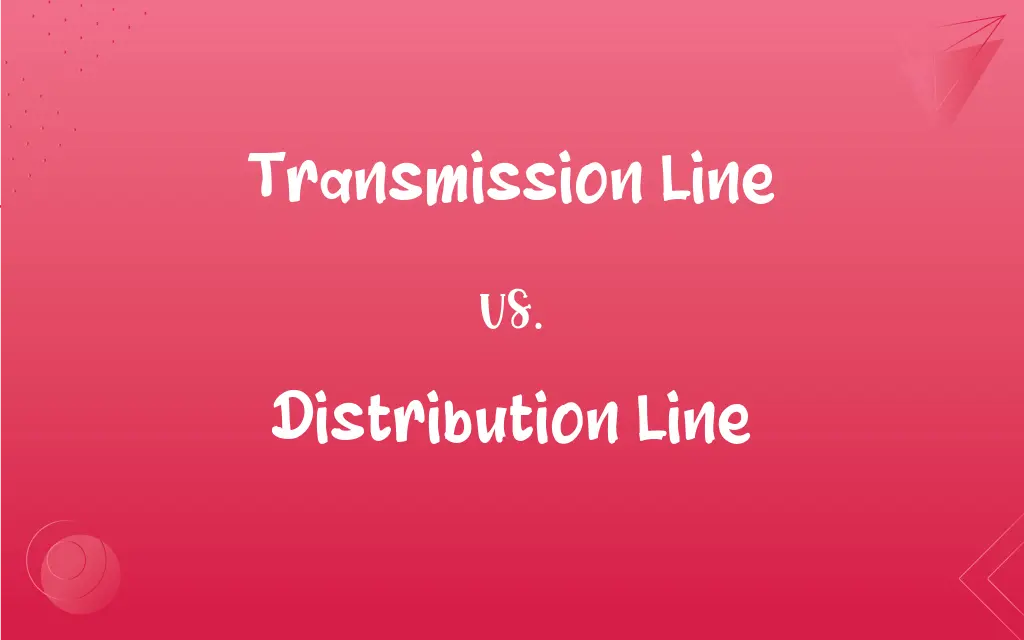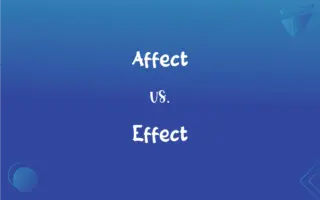Transmission Line vs. Distribution Line: What's the Difference?
Edited by Aimie Carlson || By Harlon Moss || Updated on October 13, 2023
Transmission Line is a high-voltage lines transporting electricity over large distances. Distribution Line is lower-voltage lines distributing electricity to end-users.

Key Differences
A transmission line traditionally functions to convey electrical power over substantial distances from generating stations to substations. In contrast, a distribution line directly delivers this electrical power from substations to residences, businesses, and other consumers.
Distribution lines operate at lower voltages than transmission lines, and are essential for the actual provisioning of power to individual consumers. Whereas transmission lines facilitate the broad movement of electric power, distribution lines manage the localized dissemination of this power.
Transmission lines usually are characterized by very high voltages, often exceeding 115kV, designed to transmit electricity over the vast spans with minimal loss. While distribution lines deal predominantly with bringing power to users, transmission lines secure its travel over long expanses from power plants.
The distribution line is what most people commonly see along streets, characterized by lower voltages typically below 33kV. While transmission lines are pivotal in long-range electricity conveyance, distribution lines bridge the gap between substations and consumers, ensuring power reaches households and businesses.
Transmission lines tend to be situated elevated or distantly from populated areas due to their high voltage and are often seen crossing undeveloped areas. Distribution lines, conversely, are embedded within communities, demonstrating a stark contrast in the geographical and spatial presence of the two.
ADVERTISEMENT
Comparison Chart
Primary Function
Transmits power over long distances.
Distributes power to end-users.
Voltage Level
High-voltage (often >115kV).
Lower-voltage (typically <33kV).
Geographical Presence
Often traverse uninhabited areas.
Commonly seen in populated areas.
End Point
Directs power to substations.
Directs power to consumers’ premises.
Physical Proximity to Consumers
Generally distant/remote.
Close and directly linked to consumers.
ADVERTISEMENT
Transmission Line and Distribution Line Definitions
Transmission Line
Transmission lines can be overhead or underground cables designed to deliver electrical power.
The overhead transmission line was constructed to avoid excavation and disruption to the landscape.
Distribution Line
Distribution lines are characterized by their lower voltage levels as compared to transmission lines.
The distribution line delivered power to residential areas at a safe voltage level.
Transmission Line
Transmission lines can also refer to channels that transmit any kind of signal, energy, or data from one location to another.
The data was sent over the transmission line at high speed.
Distribution Line
Distribution lines can be overhead or underground, depending on regional infrastructure and policies.
To preserve the city’s aesthetic, the council opted for underground distribution lines.
Transmission Line
A transmission line is an electrical line that moves large quantities of high-voltage power between points.
The transmission line spans hundreds of kilometers, connecting the power plant to the city.
Distribution Line
Distribution lines often encompass transformers to step down voltage for safe household and business use.
Transformers along the distribution line ensured that consumers received electrical power at a usable voltage.
Transmission Line
In telecommunication, a transmission line can be a path that propagates signals from the transmitter to the receiver.
Engineers are working on establishing a new transmission line to enhance network connectivity.
Distribution Line
A distribution line is an electrical conductor that facilitates the transfer of electricity to end-users.
The neighborhood experienced a power outage due to a fault in the distribution line.
Transmission Line
Transmission lines, in power systems, are designed to convey electricity with minimized losses over great distances.
To ensure minimal loss, the transmission line was equipped with specialized materials.
Distribution Line
Distribution lines function to provide electricity directly to homes, businesses, and local infrastructure.
Every house in the area was connected to the central substation by a distribution line.
FAQs
What’s a transmission line’s primary purpose?
To transport high-voltage electricity over long distances from power plants to substations.
Are distribution lines more common in residential areas?
Yes, distribution lines are prevalent in residential and commercial areas to provide power to end-users.
Can both transmission and distribution lines be found overhead and underground?
Yes, both types of lines can be implemented overhead or underground, depending on various factors like location, cost, and local regulations.
How does voltage in a transmission line typically compare to a distribution line?
Transmission lines carry higher voltages, often over 115kV, while distribution lines carry lower voltages.
Why do distribution lines usually have transformers along them?
Transformers on distribution lines step down the voltage to usable levels for residential and commercial use.
What happens when a distribution line fails?
A failure in a distribution line can cause power outages in the directly connected area or locality.
How are transmission lines connected to power plants?
Transmission lines are connected to power plants and carry the generated electricity to substations.
What’s the difference in the physical structure between transmission and distribution lines?
Transmission lines usually have larger and taller towers/poles and conduct higher voltage than distribution lines.
Why are transmission lines often situated away from populated regions?
Due to their high voltage and potential risks, transmission lines are typically placed away from densely populated areas.
Is electricity from transmission lines usable for home appliances?
No, the high voltage in transmission lines needs to be stepped down via substations before being distributed to homes.
What’s the role of substations in electricity distribution?
Substations reduce the high voltage from transmission lines to a lower voltage suitable for distribution lines.
Can I identify a distribution line in my area?
Yes, distribution lines are commonly found along streets and poles in residential and commercial areas, often paired with transformers.
What role does a distribution line play?
Distribution lines deliver lower-voltage electricity from substations directly to consumers.
Do distribution lines directly connect to consumers?
Yes, distribution lines deliver electricity directly to consumers, powering homes and businesses.
Are transmission lines longer than distribution lines?
Typically, yes. Transmission lines are designed to transport electricity over larger distances than distribution lines.
Can distribution lines affect local electricity quality?
Yes, issues in distribution lines can directly impact the quality and supply of electricity to connected consumers.
Why are transmission lines often made of high-conductivity materials?
High-conductivity materials minimize power loss over the long distances that transmission lines cover.
Do distribution lines serve individual localities?
Yes, distribution lines specifically serve localized areas, providing power to homes and businesses therein.
Are transmission lines susceptible to weather impacts?
Yes, transmission lines, especially overhead ones, can be affected by weather conditions like storms, lightning, and ice.
Can faults in transmission lines affect power supply?
Yes, faults in transmission lines can disrupt the power supply to the connected substations and consequently, to larger areas.
About Author
Written by
Harlon MossHarlon is a seasoned quality moderator and accomplished content writer for Difference Wiki. An alumnus of the prestigious University of California, he earned his degree in Computer Science. Leveraging his academic background, Harlon brings a meticulous and informed perspective to his work, ensuring content accuracy and excellence.
Edited by
Aimie CarlsonAimie Carlson, holding a master's degree in English literature, is a fervent English language enthusiast. She lends her writing talents to Difference Wiki, a prominent website that specializes in comparisons, offering readers insightful analyses that both captivate and inform.
































































